The Mac Pro Review (Late 2013)
by Anand Lal Shimpi on December 31, 2013 3:18 PM ESTSSD
The new Mac Pro does the right thing and abandons internal hard drives in favor of high-speed PCIe based storage. You could argue wanting more internal PCIe storage, but hard drives don’t belong inside this machine - for that there’s Thunderbolt 2.
There’s a single proprietary Apple PCIe SSD connector and module inside the new Mac Pro. The connector looks similar to what’s in the new MacBook Pro but I haven’t verified compatibility. Unlike the new MacBook Pros, the Mac Pro SSDs only ship in a x4 PCIe configuration. The result is faster peak sequential speeds.
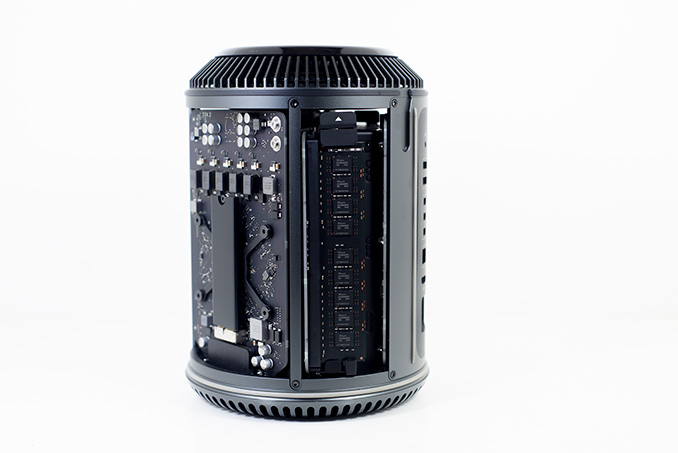
Custom SSD behind the GPU board on the left
My review sample had a 512GB Samsung XP941 based drive. I believe this is a 2-bit-per-cell MLC design with a 512MB LPDDR2-1066 DRAM. Samsung’s SSD architectures have evolved pretty well over the years. As long as you’re careful not to completely fill the drive you should be ok from an IO consistency standpoint as well. I continue to recommend keeping around 15 - 20% of the SSD free if you want to keep performance at a relatively high level. Definitely keep this in mind if you’re torn about what capacity drive you should outfit your system with.
| Mac Pro (Late 2013) SSD Options | ||||||
| 4-Core Config | 6-Core Config | |||||
| 256GB | Included | Included | ||||
| 512GB | +$300 | +$300 | ||||
| 1TB | +$800 | +$800 | ||||
Apple offers three SSD capacities with the new Mac Pro: 256GB, 512GB and 1TB. Both default configurations come with a 256GB drive. Upgrades to 512GB/1TB cost the same regardless of your starting point: $300 and $800, respectively. Chances are you’re going to depend fairly heavily on external storage for media, which leaves you the flexibility of sticking with the base 256GB configuration. Personally I’d use the Mac Pro just as much as a regular PC (including gaming) as I would for photo/video work, so I’d push for the highest capacity SSD possible. Since Apple isn’t using a standard connector or form factor here, you can’t necessarily count on anyone offering a decent aftermarket solutions (although OWC has done so in the past). If OWC or anyone else was brave enough to produce an aftermarket Mac Pro SSD, it might come with fewer tradeoffs compared to what we’ve seen in the portable Mac space. I’m primarily talking about ultra low idle power not being as much of an issue for an SSD in the Mac Pro. Last time I looked, OWC’s aftermarket MacBook Air/Pro SSDs consumed more power at idle compared to the Apple OEM drives. The same issues wouldn’t matter in a Mac Pro.
I ran the 512GB SSD through our standard four-corners Iometer test suite. The numbers were expectedly a bit higher than what I measured on the 15-inch Haswell rMBP and the 21.5-inch Haswell iMac thanks to the drive’s PCIe x4 interface. Random write performance takes a step backwards but all of the results we're showing here are more than enough for single user workstation use. Although Mavericks itself seems to have issues that can cause high latency IO (particularly around quicklook), the SSD in the Mac Pro performed quite well.
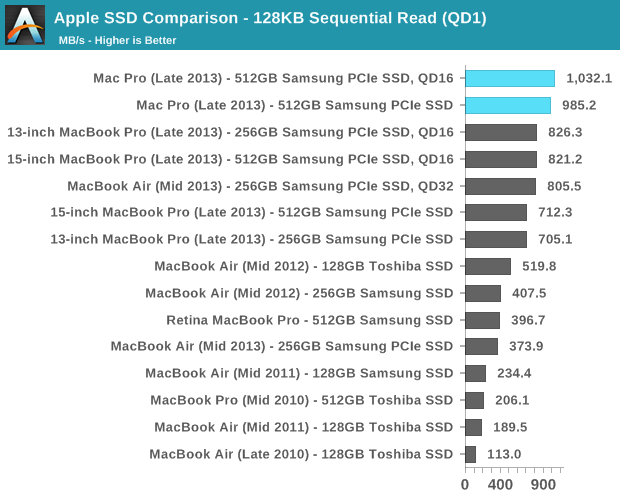
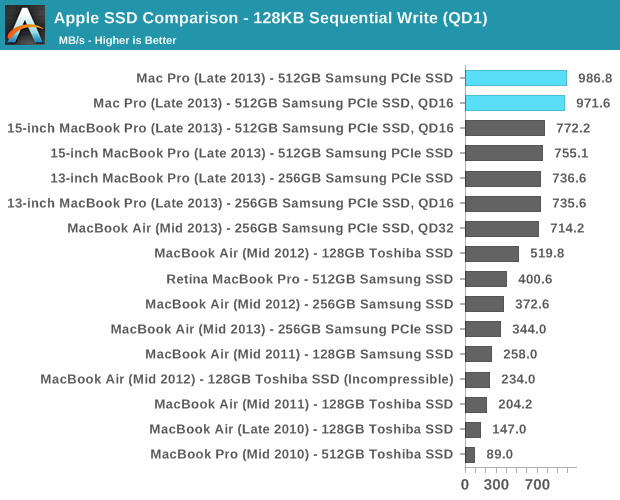
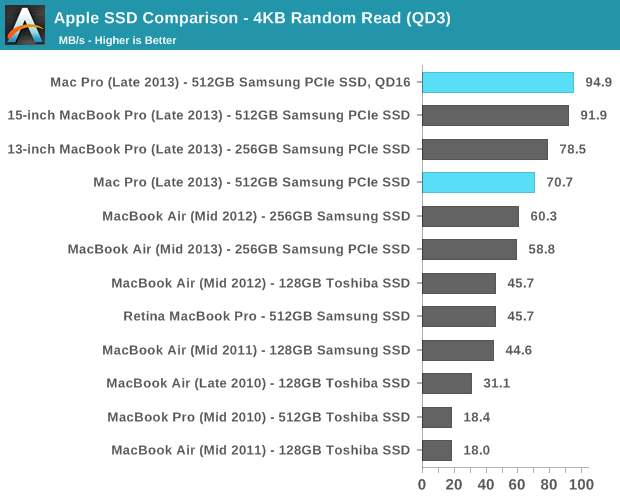
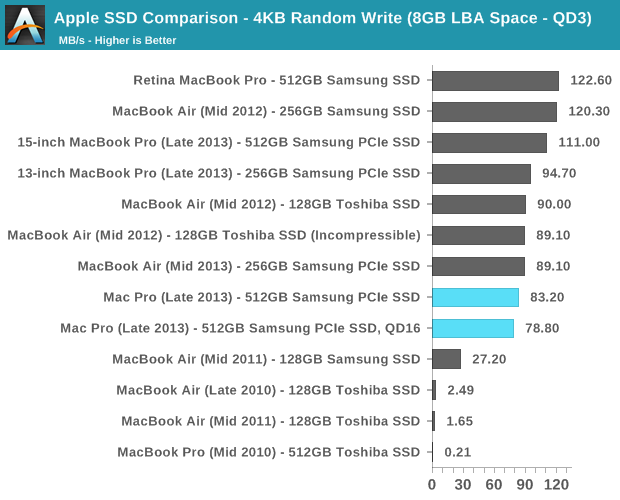
I’m beyond pleased to see that Apple has moved its Mac lineup virtually top to bottom to PCIe SSDs. This is absolutely the right approach, and one that all other OEMs should follow.
Gigabit Ethernet & WiFi
Broadcom won all of the networking sockets in the new Mac Pro. Each machine ships with two BCM57762 Gigabit Ethernet controllers and a BCM4360 802.11ac controller. Each controller is connected to its own PCIe 2.0 x1 lane, guaranteeing it more than enough bandwidth to operate at full speed. The GigE ports on the back of the Mac Pro are thus independent and can sustain full bandwidth in tandem.
The 802.11ac solution is the same 3-stream BCM4360 you’ll find in the new Haswell MacBook Pros. The Broadcom controller supports 80MHz wide channels and 256 QAM, resulting in a peak theoretical data rate of 433Mbps per stream. With three streams that works out to be a max negotiated PHY rate of 1.3Gbps.
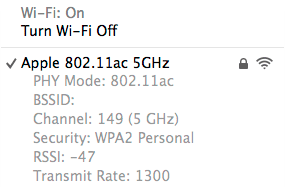
In practice I found the Mac Pro’s WiFi performance in best conditions to be similar to that of the 21.5-inch 2013 iMac, which ships with the same hardware. Over UDP that amounts to just under 900Mbps, and a bit over 600Mbps over TCP. You’re still better off using GigE if you can, but 3-stream 802.11ac is arguably good enough if you can’t get a cable down to your Mac.
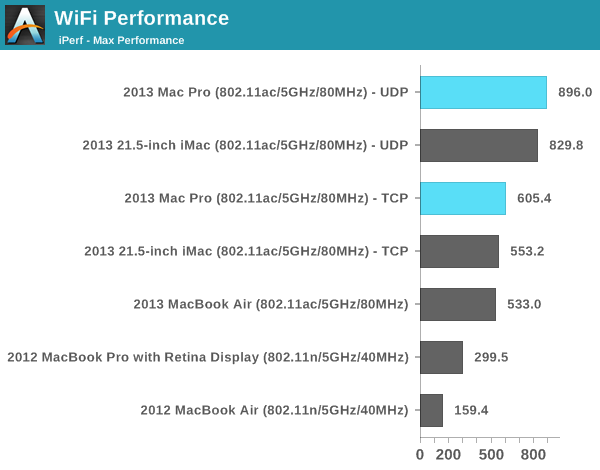











267 Comments
View All Comments
wallysb01 - Friday, January 3, 2014 - link
Actually, you can upgrade the CPU. What you can’t do is replace the monitor.Liquidmark - Friday, January 3, 2014 - link
You can attach external monitors to the iMac.Liquidmark - Friday, January 3, 2014 - link
"The problem with saying Apple's pricing isn't out of touch with reality is that you can't only compare this to high end workstation's from other companies..."This is a workstation. It has workstation components and is formally classified as such, so you kinda have to compare it to *gasp* OTHER workstations and match their spec as closely as possible to see if the price of the Mac Pro is reasonable or not. Anand is absolutely correct in comparing this to a HP Z420 which is HP's mid-range workstation right now.
"this is Apple's only desktop-ish device."
Ever heard of the Mac Mini?
"Apple doesn't provide options for people who want a high end notebook or desktop for normal use.."
Ever heard of the Macbook Pro or iMac?
You can't discount the fact that the Mac Pro has Xeons under the hood just because you don't like the other options Apple offers. If the Mac Pro has Xeons under the hood, then you have to factor that into the price of the device. You don't get to ignore the engine in a Bently to claim that a Bently is thus overpriced when compared to a Toyota Corolla. You don't get to say that it should have an engine from a Toyota Corolla and that theuy shouldn't have the luxury features and hand-crafted attention to detail that come with a bently. If you want a Toyota corolla, go buy a Toyota Corolla. If you want a Dodge viper, go buy that. Don't tell Bently to make a Toyota Corolla or a Dodge viper and don't expect to buy a bently at the cost of a toyota corolla or dodge viper either because you seem to dismiss the facts that there are differences between the three.
"it's at least 2x as expensive as it should be for it's base unit"
Not according to actual price comparisons it isn't..
Bobs_Your_Uncle - Thursday, January 2, 2014 - link
I'm still wondering how that Nokia Lumia 1020 review is coming along !?p51mustang6 - Thursday, January 2, 2014 - link
You should really do research, just a little, prior to making a review like this, you make a bold statement saying how the Mac Pro is so great and for so cheap, yet you compared it to two companies far from known for making anything professional. Try comparing the Mac Pro to The Origin Genesis Pro-X2 from Origin PC. It starts out with considerably higher specs with a LOWER price tag. They also offer up to dual Intel Xeon E5-2697 Dodeca-core processors (that's 12 cores each CPU for those of you who couldn't handle that) for a total of 24 cores (or twice that of the Mac Pro), up to dual 12GB NVIDIA Quadro K6000s (Apple doesn't even offer anything even closely comparable lol), up to 256GB of RAM (Apple offers up to 64GB), up to 4TB of SSD storage (compared to Apple's 1TB, granted PCI), comes standard with liquid cooling (Apple does not offer), up to an additional 12GB NVIDIA Tesla K40 (once again Apple offers nothing of the sort), Origin comes with one year warranty upgradable to 3 years but also comes standard with LIFETIME support with 24/7 United States based support (I wonder where Apple's support that you get 90 days of is based...lol) The starting price of the Origin is $3,712 compared to $3,999 of the Mac Pro which does not come with dual processors. The trash can is a complete rip off which requires you to go out and use their thunderbolt ports in order to do any real upgrading so you will have random things sitting on your desk, the Origin perhaps bigger, but at least all the goods will always be inside of it. Instead of spending all their time trying to make a computer a cylinder maybe Apple should have tried to compete with the real heavy hitters such as Origin PC.Louiek - Thursday, January 2, 2014 - link
Hi, I am currently myself trying to compare a maxed out mac pro ~ $10k CAD with other OEM workstations of similar spec. I looked into origin but I can't seem to build a similar spec'd (i.e. single Xeon E5-2697v2 etc) that will cost under $11k CAD. Is there something I am missing as your comment leads me to believe that I can build a cheaper PC with origins with similar specs.Liquidmark - Friday, January 3, 2014 - link
You can't the Origin machine only offers extreeeeme options that are ideal for gaming with neon lights. Its solution to things is to throw more cores at it and throw more ram at it even though the ram is slower...stingerman - Thursday, January 2, 2014 - link
Sorry dude, triedto configure a comparable system and it costs more than the Mac Pro...Liquidmark - Friday, January 3, 2014 - link
Ok, I'll bite...Mac Pro:
2.7GHz 12-core with 30MB of L3 cache
32GB (4x8GB) of 1866MHz DDR3 ECC
256GB PCIe-based flash storage
Dual AMD FirePro D700 GPUs with 6GB of GDDR5 VRAM each
User's Guide (English)
$8000 and weighs roughly 11 pounds
GENESIS Pro-X2
ASUS Z9PE-D8 WS
Dual ORIGIN FROSTBYTE 120 Sealed Liquid Cooling Systems
Dual Intel XEON E5-2630 v2 Hex-Core 2.6GHz (3.1GHz Turbo) 15MB Cache (That's 12 cores at a lower clock than the Mac Pro build)
1000 Watt Corsair RM1000
Dual 6GB NVIDIA Quadro 6000 (Non-SLI)
32GB Kingston ECC 1600MHz (4x8GB)
Genuine MS Windows 7 Professional 64-Bit Edition
250GB Samsung 840 Evo Series
ASUS 24X CD/DVD Burner
On Board Audio
Onboard Network Port
ORIGIN Wooden Crate Armor
1 Year Part Replacement and 45 Day Free Shipping Warranty with Lifetime Labor/24-7 Support
ORIGIN Recovery USB3.0 Flash Drive
ORIGIN PC G8 T-Shirt XL
Microsoft Internet Explorer
$11,017 and weighs over 70 pounds.
Now, before anyone says anything, the tee shirt was free and the water cooling was the only offer plus they give a free games offer that I didn't take. Tho I probably should since apparently workstations are all about pro gaming, neon lights and being extreeeeeme.
Liquidmark - Friday, January 3, 2014 - link
Also, if anyone wants to argue that you can get dual 12-core on the origin machine, I'll simply point out that, at spec, I'd almost be able to buy two 12 core Mac Pros. Just saying.